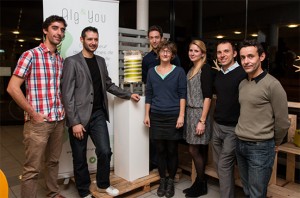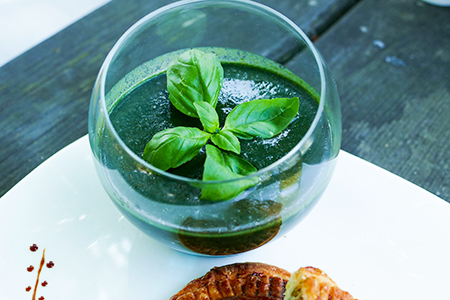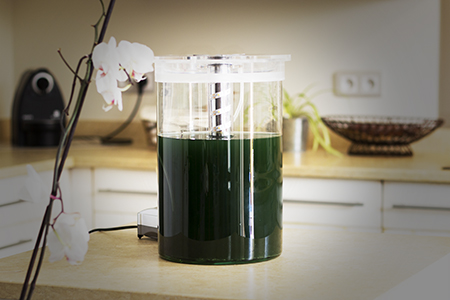
The eChlorial team met George Garcia, creator of the “Phytotière”! Interview extracted from the book “Savez-vous goûter…les algues?”
Georges Garcia is an engineer and philosopher by training. Pierre Mollo passed on his passion for plankton to him, and since 2010, through the development of “phytotières”, he has been aiming to make spirulina and micro-algae a food for all, through local production. This project led to the creation of the La Voie bleue association and the Alg & You company, which won awards in the “Plant Proteins” category of the World Innovation Contest 2030 in 2014 and 2015.
Like Parmentier with the potato in the 18th century, this man from Toulouse is campaigning for micro-algae to make their way onto our tables in France and elsewhere. He wants to surround himself with companies, NGOs, laboratories, restaurateurs and enthusiasts to make these micro-algae accessible to our wallets and culinary expectations. To do this, we need to imagine ways of cultivating them, making good use of technology and relying on our individual and collective capacities to meet our food needs.
What makes you think that the time for microalgae has come?
Malnutrition affects more than 800 million people. Populations are becoming increasingly urbanized, with no access to land. Iron, vitamin A and iodine deficiencies affect 2.5 billion human beings! As a result of population growth, our protein consumption will increase by 40% by 2030, a level that will be difficult to achieve without aggravating malnutrition if we do not focus on plant proteins. Three microalgae are currently authorized for consumption, and there may be many more in the future. Spirulina and chlorella are champions when it comes to ideally assimilable proteins ( organic spirulina can produce 200 times more than beef per unit area!), and Odontella produces the omega-3 we’re looking for at the other end of the food chain, even though the first link in the chain already contains it.
What are the obstacles to overcome before microalgae reach our plates?

Bringing about lasting changes in eating habits is always a slow process. Microalgae also have strong symbols: they grow in an unusual substrate, water, and are invisible to the naked eye… So, it’s interesting to mobilize chefs, to allow all creative people to imagine recipes in line with their gastronomic universe. And then we’re going to develop access to microalgae in fresh form, and no longer exclusively in the dehydrated form sold today. The eggs, vegetables and meat we buy contain 65-90% water, so why dehydrate spirulina? In fresh form, it can be kept in the fridge for a week, and looks like a spread. The more nuanced aromatic palette of the fresh product, its interesting texture, and its taste-enhancing and acidity-correcting properties make it a discreet ingredient on the palate, halfway between a fromage frais and an egg yolk. This pigment-packed food of the future is rich in color… but also in essential nutrients!
The phytotière, phytoplankton yogurt maker
How about growing algae at home to feed yourself? Mostly produced in large quantities on mega-farms, microalgae are then dried before being packaged and shipped to distribution outlets. The FAO (Food and Agriculture Organization of the United Nations) supports the development of small-scale spirulina cultivation, just as it encourages the relocation of food production.
So, when will we see plankton gardens on our balconies or on the roofs of our buildings? What seems futuristic today may soon become a valued innovative practice, and the phytotiere project could be the kick-off. Based on the principle that microalgae develop easily and need only a small volume of water to grow, Alg & You is currently working on the design of a production system for food-grade microalgae, known as a “phytotière”. By way of example, a 10 l phytotière will generate 20 g of fresh spirulina paste per day.
The name phytotière was chosen by analogy with the yogurt maker. Yogurt is also the culture of a micro-organism (yeast) and, until the 1950s, was only sold in pharmacies. Then it became the dessert we know, thanks in no small part to the famous yogurt makers.
Hence the prospects for spirulina and chlorella, still confined to the shelves of parapharmacies and health food stores. How long will it take them to reveal their potential as a food ingredient?
The Blue Way
At a time when the green revolution in agriculture is showing its limits in terms of contamination and soil impoverishment, other avenues need to be explored, such as the “blue way”, the color of our planet and its oceans. Certain species of microalgae are proving highly interesting for our food. Is microalgae agriculture possible and desirable? Is microalgae gastronomy desirable? La Voie bleue is the name of an association created in 2013; it will soon also be the name of a label recognizing the social and environmental dimensions of initiatives facilitating access to microalgae food. A collaborative platform, the association brings together a wide range of players ready to develop, in the form of a common good, the knowledge needed to create new food chains making microalgae accessible to as many people as possible, and in particular to the most disadvantaged.

